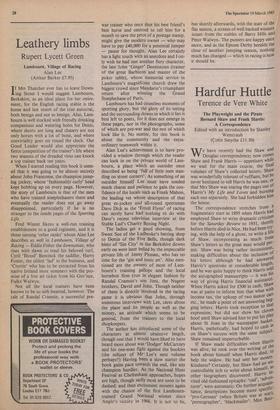Leathery limbs
Rupert Lycett Green
Lambourn, Village of Racing Alan Lee (Arthur Barker £7.95)
11 Mrs Thatcher ever has to leave Down-
ing Street I would suggest Lambourn, Berkshire, as an ideal place for her retire- ment, for the English racing stable is the home and last resort of the true autocrat, both benign and not so benign. Also, Lam- bourn is well stocked with friendly drinking companions and watering holes for Denis, where shorts are long and chasers are not only horses with a lot of bone, and where conviviality goes on round the clock. Our Good Leader would also appreciate the fierce competition of the trainer's life where two seasons of the dreaded virus can knock a top trainer back ten years.
When I started reading this book it seem- ed that it was going to be almost entirely about John Francome, the champion jump- ing jockey, whose 'fashionably curly' head kept bobbing up on every page. However, the story of Lambourn is that of the men who have trained steeplechasers there and eventually the reader does not go away disappointed, particularly if he is no stranger to the inside pages of the Sporting Life.
Fred Winter likens a well-run training establishment to a good regiment, and it is those unsung 'other ranks' whom Alan Lee describes so well in Lambourn, Village of Racing — Eddie Fisher the downsman, who rises with dawn to tend his beloved turf, Cyril 'Blood' Bentinck the saddler, Harry Foster, the oldest 'lad' in the business, and `Crottie' who has to be extracted from his native Ireland most summers with the pro- mise of a free air ticket from his Guv'nor, Fulke Walwyn.
Not all the local trainers have been known to be so soft-hearted, however. The tale of Randal Cramsie, a successful pre-
war trainer who once shot his best friend's best horse and omitted to tell him for a month to save the price of a postage stamp, might give the modern owner — who may have to pay £40,000 for a potential jumper — pause for thought. Alan Lee certainly has a light touch with an anecdote and I on- ly wish he had met another fiery character, the late John 'Ginger' Dennistoun (trainer of the great Barbizon and master of the poker table), whose memorial service in Lambourn's magnificent church drew the biggest crowd since Mandarin's triumphant return after winning the Grand Steeplechase of Paris.
Lambourn has had countless moments of sporting glory, but the glory of its setting and the surrounding downs in which it lies is best left to poets, for it does not emerge in these pages, nor in the photographs, some of which are pre-war and the rest of which look like it. No matter, for this book is about the community and the extra- ordinary teamwork within it.
Alan Lee's achievement is to have pro- vided a window through which the reader can look in on the private world of Lam- bourn, a place which an outsider once described as being 'full of little men stan- ding on street corners'. As something of an outsider himself Lee must have needed much charm and patience to gain the con- fidence of the locals such as Frank Mahon, the leading vet whose description of that great ex-jockey and all-round sportsman Dave Dick as the 'Erroll Flynn' of racing can surely have had nothing to do with Dave's recent television interview at the Stable Lad's Charity Boxing Night.
The ladies get a good showing, from Sweet Sue of the Ladbroke's betting shop to Dottie of the Five Bells, though dark hints of 'Sin City' in the Berkshire downs early on were later belied by the impeccable private life of Jenny Pitman, who has no time for the 'gin and tonic set'. Also men- tioned are the owners of most of Lam- bourn's training gallops and the local horsebox firm (run in elegant fashion by Randal Cramsie's son Jim), the Nugent brothers, David and John. Though neither of them is directly involved in the racing game it is obvious that John, through numerous interviews with Lee, cares about the place and its people as well as the money, an attitude which seems to be general, from the trainers to the local shopkeepers.
The author has introduced some of the characters at almost obsessive length, though one that I would have liked to have heard more about was 'Dodger' McCartney and his one-man fight against the bookies (the subject of Mr Lee's next volume perhaps?) Having been a slow starter the book gains pace towards the end, like any champion hurdler. As the National Hunt Festival at Cheltenham approaches, hopes are high, though sadly most are soon to be dashed; and then excitement mounts again with the chance of the first Lambourn- trained Grand National winner since Anglo's victory in 1966. It is not to be, but shortly afterwards, with the start of the flat season, a stream of well backed winners issues from the stables of Barry Hills and Peter Walwyn. The punters are happy once more, and as the Epsom Derby heralds the close of another jumping season, nothing much has changed — which in racing is how it should be.










































 Previous page
Previous page